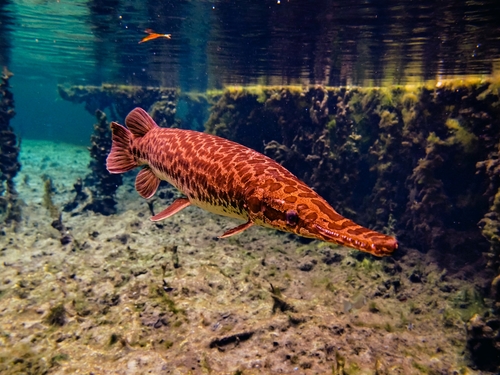
Florida Gar
Bluefin tuna, belonging to the genus Thunnus, are among the ocean's most impressive predators. Known for their incredible speed, size, and migratory habits, they are apex predators. These fish are not only vital to marine ecosystems but also hold substantial cultural and economic value.
7 10 years
Lifespan
51 - 132 cm
Length
Least Concern
Conservation Status
5 km/h
Swimming speed
Carnivorous, Insectivorous
Diet
Local Migration
Migration
Appearance Overview
The Bluefin Tuna is renowned for its large, streamlined body, built for speed and endurance.
Color
Dark metallic blue on top with a silvery underside
Fins
Two dorsal fins, the first depressible; small finlets run down the back and belly
Body
Torpedo-shaped for efficient movement through water
Length
up to 10 feet (3 meters), commonly 6.5 feet (2 meters)
Weight
up to 1,500 lbs (680 kg), commonly around 550 lbs (250 kg)
Diet
Carnivorous, feeding on a variety of fish, squid, crustaceans, and eels.
Feeding Behavior
An opportunistic predator, the Bluefin Tuna uses its speed and agility to hunt. It often feeds cooperatively, herding prey fish into tighter formations.
Social Behavior
Highly migratory, forming large schools, especially when young. They can segregate by size and sometimes join mixed schools with other tuna species.
Commercial Relevance
Extremely high value, particularly in sushi and sashimi markets. It is one of the most commercially important fish species, driving significant economic activity.
Conservation measures
Management includes strict fishing quotas, seasonal closures, minimum size limits, and international agreements to monitor and control catch levels. Efforts are also focused on reducing bycatch.
Status
Varies by species; Atlantic Bluefin is Endangered, Pacific Bluefin is Near Threatened, and Southern Bluefin is Critically Endangered.
Threats
Primarily threatened by overfishing due to high demand. Other threats include habitat degradation, climate change affecting prey distribution, and bycatch in other fisheries.
Habitat Distribution
Depth Range
0-900 meters (0-2,953 feet), though they are most commonly found in surface to mid-waters (up to 200 meters).
Geographic Range
Atlantic Bluefin: Western and Eastern Atlantic, Mediterranean Sea. Pacific Bluefin: North Pacific Ocean. Southern Bluefin: Southern Hemisphere oceans.
Preferred Environment
Temperate and subtropical waters; highly migratory, often found in open ocean environments but also come closer to coastal areas.
Reproduction and Life Cycle
Breeding Habits
Spawns in warm waters; Atlantic Bluefin spawns in the Gulf of Mexico and the Mediterranean Sea, Pacific Bluefin near Japan, and Southern Bluefin in the Indian Ocean.
Development Stages
Eggs hatch into larvae that drift with plankton. Juveniles grow rapidly, forming schools. They transition through various life stages, becoming apex predators as adults.
Fecundity
Highly fecund; a single female can produce up to 30 million eggs per spawning season, depending on size and condition.
Maturity Age
Varies by species; Atlantic Bluefin typically matures at 4-8 years, Pacific Bluefin at 3-5 years, and Southern Bluefin at 8-12 years.
Faqs about Florida Gar
Why is Bluefin tuna so popular in cuisine?
Bluefin tuna is highly prized for its rich, fatty flesh, especially in Japanese cuisine where it is a key ingredient in sushi and sashimi.
How long do Bluefin tuna live?
Bluefin tuna can live up to 40 years, although this varies by species.
How fast can Bluefin tuna swim?
Bluefin tuna are among the fastest fish, capable of swimming at speeds up to 43 mph (70 km/h) in short bursts.
Are Bluefin tuna warm-blooded?
Yes, they are warm-blooded, which allows them to maintain a body temperature higher than the surrounding water, aiding in their speed and endurance.
How far do Bluefin tuna migrate?
They migrate across vast distances, often crossing entire oceans, following food sources and returning to specific spawning grounds.
Copyright @ Nature Style Limited. All Rights Reserved.
 English
English